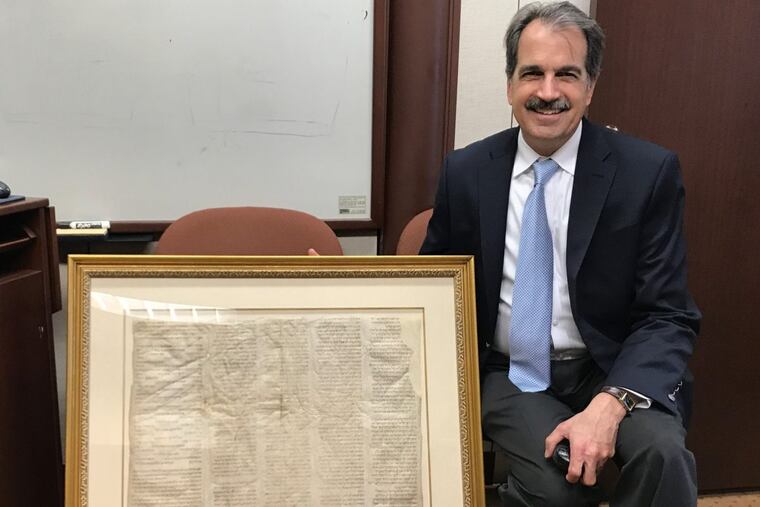Ancient Torah scroll sheet preserved for public display. A Rutgers professor played a vital role in its acquisition
The Library of Congress recently got its hands on a Torah scroll sheet that dates to the 10th or 11th century, the earliest known legible version of the "Song of the Sea" - and a Rutgers expert played a vital role in its acquisition.

The Library of Congress recently got its hands on a Torah scroll sheet that dates to the 10th or 11th century, the earliest known legible version of the "Song of the Sea" and an invaluable find — and a Rutgers University professor played a vital role in its acquisition.
Detailing the flight of the Jewish people from Egypt, the vellum sheet measures 23 by 23.5 inches and contains Exodus 10:10 to 16:15, beginning with the "Ten Plagues" and continuing through the "Song of the Sea."
Though the oldest legible Torah scroll sheets are the Dead Sea Scrolls, which predate the "Song of the Sea" scrolls by around 1,000 years, this scroll is still a remarkable find, said Ann Brener, head of the Hebraic section of the Library of Congress' African and Middle Eastern division.
"What makes this scroll sheet so special is that it is the oldest legible scroll sheet in which the 'Song of the Sea' – the song in which the children of Israel celebrate the transition from slavery to freedom – is written," she said.
Gary Rendsburg, a professor of Jewish studies at Rutgers, helped to identify the scroll sheet before the library purchased it from a bookseller's catalog.
Brener happened across the Torah sheet scroll in a private catalog that offered only a description of the sheet, with no photos provided.
A former student of Rendsburg's at the Graduate School at Cornell University, she sent him the link to the catalog via email, hoping that he would be able to help identify the scroll sheet by description. He did so within minutes.
"I knew immediately what it was, because in the year 2001, the same text was sold at Christie's in London at auction," Rendsburg said.
While the scroll sheet was for sale, professor Jordan Penkower of Israel's Bar Ilan University was invited to London to study the manuscript, and wrote a scholarly article detailing its authenticity.
Rendsburg had read Penkower's 20-page treatise, and knew right away that the scroll sheet Brener found was Penkower's subject of study, resurfacing more than a decade later.
Much of the history of the scroll sheet's travel remains hazy, but historians have been able to fill in a few of the gaps.
Rendsburg said its Hebrew letters tell them it was written somewhere in the Middle East, and for unknown reasons, this single part of the scroll was preserved.
On the back of the sheet is an inscription from around 1860, written in both in Hebrew and Russian, indicating that it was given by a group of Jews living in Crimea to the archduke brother of the czar of Russia.
From there, history again becomes unclear.
It's entirely possible, he said, that it was folded and smuggled out of the country based on folds on the sheet, but as of now, that is speculation. The scroll sheet's history until it was sold in England is unclear.
Now, the scroll sheet is on display in the Great Hall of the Library of Congress until mid-April beside the Guttenberg Bible, the first mass-produced book in the West.
To Brener and Rensburg alike, the scroll sheet's acquisition by the Library of Congress marked a once-in-a-lifetime turn of events.
"The story of Exodus is one of the foundational texts of Western culture. It figures largely in the American narrative about freedom, and it resonates powerfully with American history. For all these reasons, it seemed to me vitally important to acquire this piece for the Library of Congress," Brener said.
Rendsburg, enthralled to be involved, remains humble about his contribution.
"I'm grateful that I was in a position to be involved, he said. "I'm getting a lot of publicity for this, but honestly, I played a small but crucial role."
"This Torah scroll sheet is a curator's dream, the kind of treasure that you just know, from the very first moment you see it in the bookseller's catalog, belongs in your institution," Brener said.